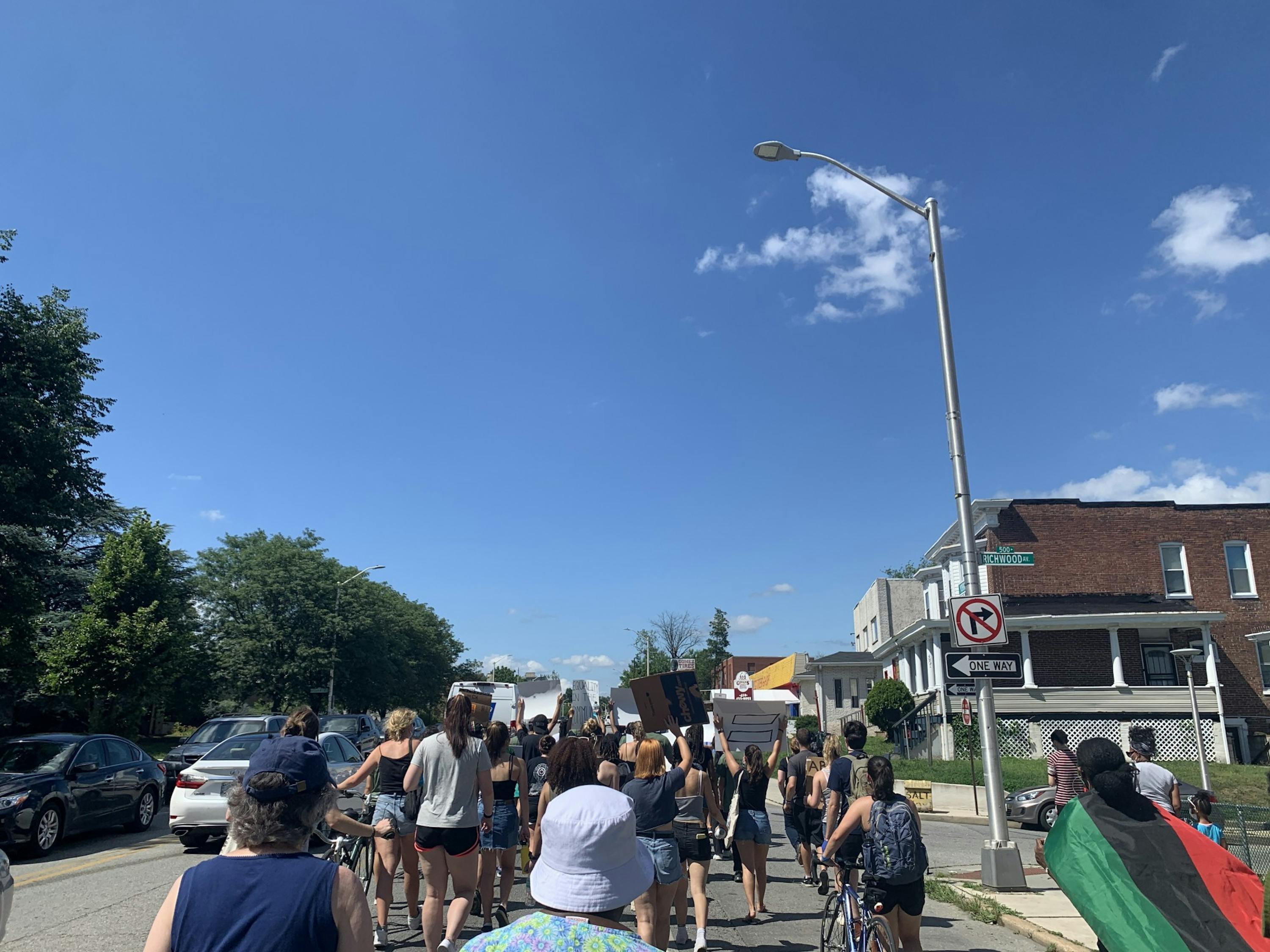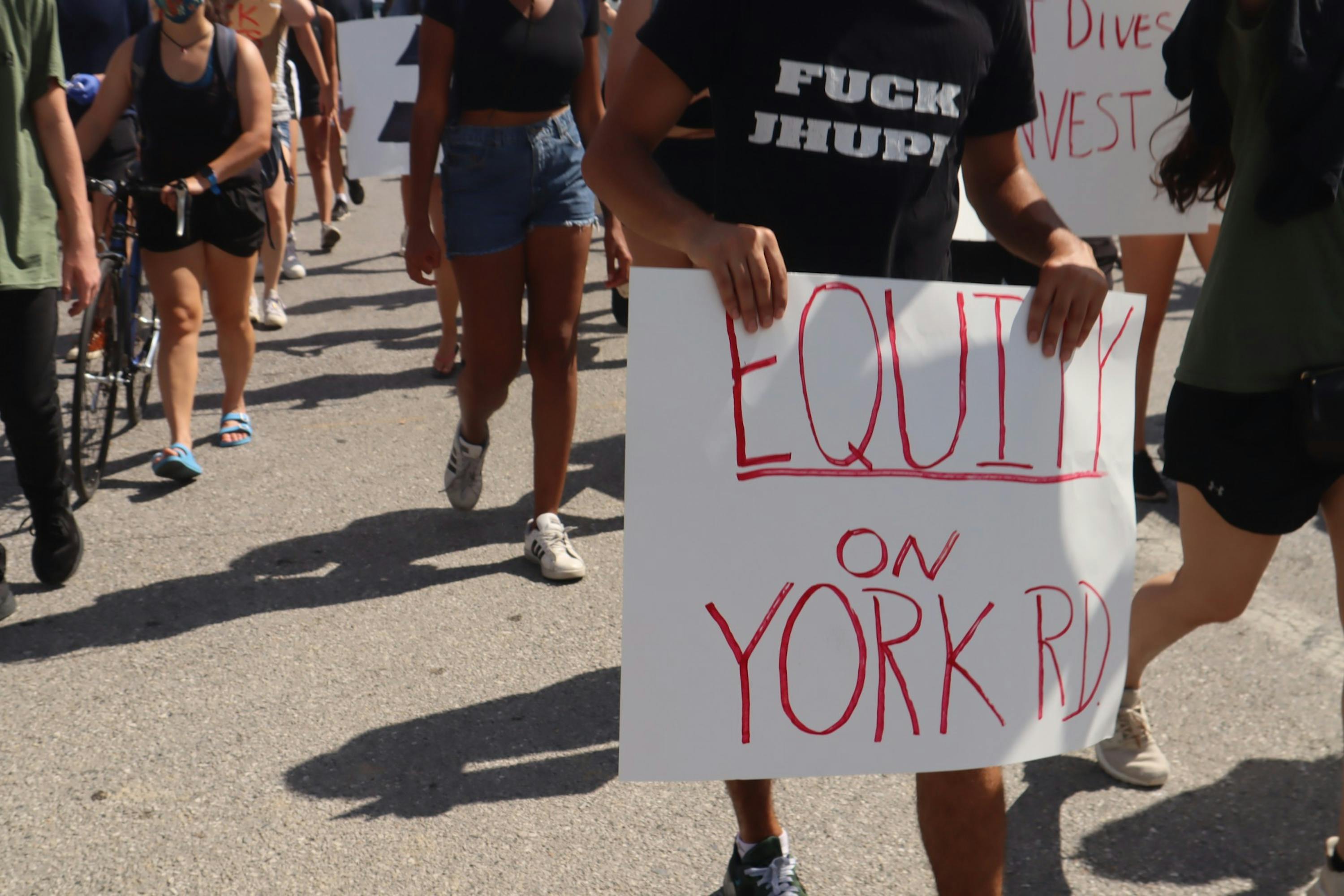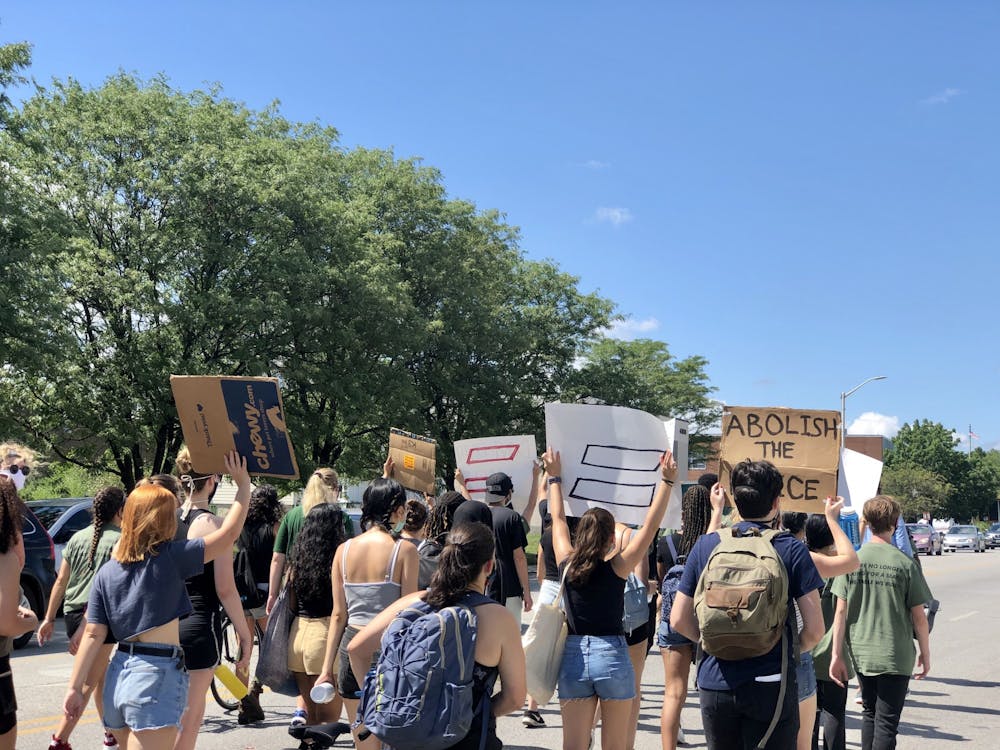A group of community activists and Hopkins students marched along York Road on July 11 to highlight racial disparities in North Baltimore.
Demonstrators first gathered at the corner of York Road and Cold Spring Lane — a symbolic intersection, according to social worker Zachery Dingle, who ran unsuccessfully in the Democratic primary for Maryland’s fourth congressional district.
In an interview with The News-Letter, Dingle stated that he has observed inequity in Baltimore throughout his lifetime.
“There is a clear disparity between the east and west sides of York Road. It was like this when I was a child, and it’s still like this today, he said. “This is typical of America — the haves versus the have-nots. At this time, we need to make an announcement that the have-nots have had enough.”
The group marched from the crossroad to the Belvedere Square Market, where Heber Brown III, the senior pastor at the Pleasant Hope Baptist Church, gave a speech. He emphasized that redlining in the 1930s caused racial disparities that still exist today.
Racist policies such as the denial of loans to non-white residents of redlined neighborhoods promoted segregation in major cities across the country. The Home Owners’ Loan Corporation considered non-white neighborhoods risky for mortgage support, outlining them in red on residential security maps that were used for decades to deny loans to people of color.
To this day, Baltimore neighborhoods that were redlined have lower rates of homeownership, worse health outcomes and higher rates of poverty and segregation.
In his speech, Brown referred to the “White L” and the “Black Butterfly,” terms coined by Morgan State University Assistant Professor Lawrence Brown. White neighborhoods in Baltimore, which form the shape of an “L,” have structural advantages over Black ones, which form the wings of a butterfly.
“The York Road community has a dirty little secret — that this is a redlined, racially segregated community. York Road is the spine of the ‘White L,’” Brown said. “This community represents a dangerous kind of racism. It’s a polite racism. It’s a ‘why can’t we all just get along?’ kind of racism. It’s a ‘let’s sing Kumbaya’ racism.”
NAACP lawyer Anson Asaka, another candidate in the Baltimore City Council elections this June, emphasized the existence of racial disparities on York Road.
“It makes no sense for someone on the east side of York Road to have a lesser life expectancy — 11 years less life than the west side of York Road. It doesn’t make sense for people on the west side of York Road to earn twice as much,” he said. “It doesn’t make sense for the people on the west side of York Road to be able to send their kids to the best elite schools in the country, while our kids go to failing schools on this side of York Road.”

COURTESY OF GRACYN SOLLMANN
Black neighborhoods that were redlined in the 1930s are structurally disadvantaged today.
Based on data collected between 2011 and 2015, the Baltimore City Health Department found in 2017 that the life expectancy in the Greater Govans neighborhood was 73.3 years old, whereas the life expectancy in the nearby Guilford/Homeland region was 84 years old. According to estimates from 2014, the median household income in Greater Govans, which is 90 percent Black, was $36,531, whereas the median household income in Guilford/Homeland, which is 70 percent white, was $81,451.
In 2008, the York Road Initiative was founded at Loyola University to improve the quality of life within the York Road corridor. In 2016, it merged with Loyola’s Center for Community Service and Justice (CCSJ).
Thaen Hardy, who organized the march, told demonstrators that she and other community leaders are working with the CCSJ to create a memorandum of understanding to set goals for change. Also known as Miss Tee, Hardy is the York Road Initiative’s opportunity youth coordinator and the founder of Village Mentality LLC, a community outreach consulting business.
A committee that Hardy created will aim to address inequity along York Road.
“Our first step is to create a dialogue series. We don’t need to have any more polite conversations; we need to have mediated conversations where we can say what we need and get it out on the table,” she said. “There’s no reason to have 20 meetings to figure out what to do. We did that already.”
The march, she stressed, is just the beginning.
Dingle, while addressing the crowd outside the Belvedere Square Market, agreed.
“So you’re tired and ready to go home, kick your feet up, but we can’t peel off this skin. I can’t peel off this Black face,” he said. “It takes an intentional drive every single day not to scream at the top of your lungs and say, ‘I’ve had enough.’ There are clear haves and have-nots, but that side had a 400-year head start — 400 years of better education, better schools and better opportunities. We can’t stay there. We can’t stand in the quicksand of anger and frustration.”

COURTESY OF MECCA MCDONALD
Organizer Tee Hardy launched a committee in order to promote racial equity.
Rising senior Mecca McDonald, who works with Safe Streets Baltimore, a public health campaign to reduce gun violence, helped Hardy organize the event.
In an interview with The News-Letter, she called on her peers to use their privilege and visit neighborhoods like the York Road corridor.
“Hopkins students should make an effort to actually come out here and be involved in the community, whether it’s buying food at local restaurants or volunteering... As Hopkins students, we’re benefiting from segregation in Baltimore,” she said. “If you’re learning about political science, learning about economics, but you can’t apply it to the real world around you, then what are you actually studying?”
Rising senior Gabriel Silveira, also part of Safe Streets Baltimore, believes that the march was a valuable opportunity for students to learn from community members.
“A lot of the activism at Hopkins sometimes feels performative, but something like this, you... figure out where you fit in and how you can actually be helpful,” he said. “That’s the most important thing you can do right now.”
In an interview with The News-Letter, Dingle shared his opinion on the role of Hopkins in community development.
“It’s something that I would hope that Morgan State and Coppin State students would have a role in, not Johns Hopkins... We welcome everybody, but we have to lead the march,” he said. “It’s great that Hopkins remains in Baltimore and has done some great work, but this is something to be done for us as a community — for us and by us.”
According to McDonald, the University should better invest in surrounding Black neighborhoods instead of implementing a private police force. Last month, administrators decided to postpone plans for the John Hopkins Police Department (JHPD) by at least two years.
Asaka argued against the establishment of the JHPD in an interview with The News-Letter.
“We already have a situation where Black communities are over-policed and victims of racial profiling and police brutality,” he said. “That only helps magnify the problem.”
Brown alluded to racist policing in his speech.
“Anybody can say, ‘Black Lives Matter’ to George Floyd all the way over there in Minnesota. Anybody can go and say, ‘No justice, no peace’ when it comes to Breonna Taylor, and they should,” he said. “But let’s not be so anxious to say, ‘Black Lives Matter’ for communities halfway across the country when we don’t raise our voices and address the systemic racism in this community right here.”
In an interview with The News-Letter, Angie Winder, chair of the 43rd district of the Baltimore City Democratic State Central Committee, expressed her desire for people to understand that she and other community leaders are tired of the status quo.
Winder, who ran in the fourth congressional district election, told marchers that now is the perfect time for change.
“We’re not asking anymore for a seat at the table that we built. We’re not going to be quiet,” she said. “We don’t have to be elected to make that change. We are going to come to the table, and if not, we’re building our own.”
Katy Wilner contributed reporting to this article.

COURTESY OF MECCA MCDONALD
Many believe that the private police force would exacerbate racial injustice in Baltimore.





